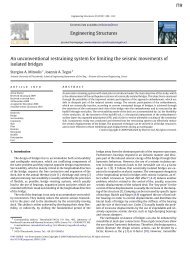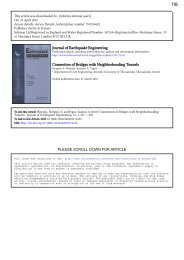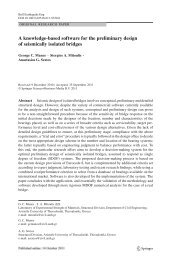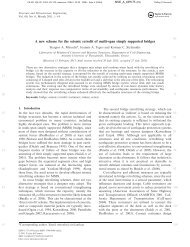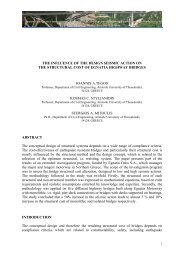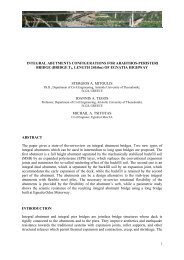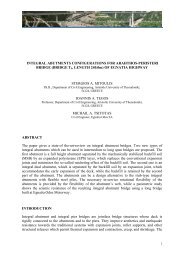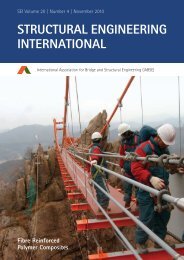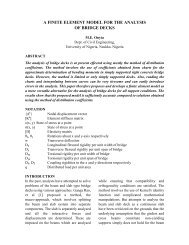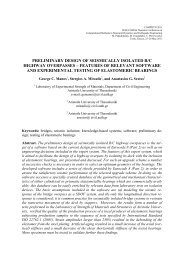24 EACS2012 Expert System for the Preliminary Design of a Seismic Isolation Scheme for Bridges
Create successful ePaper yourself
Turn your PDF publications into a flip-book with our unique Google optimized e-Paper software.
EACS 2012 – 5 th European Conference on Structural Control Genoa, Italy – 18-20 June 2012<br />
Paper No. # XXX<br />
<strong>Expert</strong> <strong>System</strong> <strong>for</strong> <strong>the</strong> <strong>Preliminary</strong> <strong>Design</strong> <strong>of</strong> a<br />
<strong>Seismic</strong> <strong>Isolation</strong> <strong>Scheme</strong> <strong>for</strong> <strong>Bridges</strong><br />
George MANOS 1, Stergios MITOULIS 2*<br />
Laboratory <strong>of</strong> Experimental Strength <strong>of</strong> Materials, Dept. <strong>of</strong> Civil Engineering,<br />
Aristotle University <strong>of</strong> Thessaloniki, Greece<br />
ABSTRACT<br />
<strong>Seismic</strong> design <strong>of</strong> isolated bridges, ei<strong>the</strong>r new or existing ones that need retr<strong>of</strong>itting, involves<br />
conceptual, preliminary and detailed design. However, preliminary design is a non-straight<strong>for</strong>ward procedure<br />
because <strong>of</strong> <strong>the</strong> sensitivity <strong>of</strong> bridge response on <strong>the</strong> initial decisions made by <strong>the</strong> designer, as well as on a<br />
series <strong>of</strong> broader criteria such as serviceability, target per<strong>for</strong>mance level and cost-effectiveness <strong>of</strong> <strong>the</strong> various<br />
design alternatives. Given <strong>the</strong> lack <strong>of</strong> design guidelines to ensure compliance with <strong>the</strong> above requirements, a<br />
“trial and error” procedure is typically followed in <strong>the</strong> design <strong>of</strong>fice to decide on <strong>the</strong> most appropriate<br />
isolation system; <strong>the</strong> latter typically based on engineering judgment to balance per<strong>for</strong>mance with cost. To<br />
this end, <strong>the</strong> particular research ef<strong>for</strong>t aims to develop a decision-making system <strong>for</strong> <strong>the</strong> optimal preliminary<br />
design <strong>of</strong> seismically isolated bridges. The proposed decision-making process is based on <strong>the</strong> current design<br />
provisions <strong>of</strong> Eurocode 8, but is complemented by additional criteria set according to expert judgment and<br />
laboratory testing, while using a combined cost/per<strong>for</strong>mance criterion. S<strong>of</strong>tware is also developed <strong>for</strong> <strong>the</strong><br />
implementation <strong>of</strong> <strong>the</strong> system. The paper concludes with <strong>the</strong> validation <strong>of</strong> <strong>the</strong> methodology and s<strong>of</strong>tware<br />
developed through more rigorous MDOF numerical analysis <strong>for</strong> <strong>the</strong> case <strong>of</strong> a real bridge.<br />
Keywords: bridges, seismic isolation, preliminary design, s<strong>of</strong>tware, experiment.<br />
1 INTRODUCTION<br />
The main objective <strong>of</strong> this research is to provide tools <strong>for</strong> helping design <strong>the</strong> isolation system<br />
<strong>of</strong> relatively regular short to medium span bridge structures as highway overpasses with <strong>the</strong><br />
emphasis being on <strong>the</strong>ir earthquake per<strong>for</strong>mance and <strong>the</strong> inclusion <strong>of</strong> elastomeric bearings in <strong>the</strong>ir<br />
design. This objective addresses both new and existing structures in an ef<strong>for</strong>t to upgrade <strong>the</strong>ir<br />
earthquake per<strong>for</strong>mance [1] [2] and is motivated by <strong>the</strong> fact that during <strong>the</strong> last decade, an extensive<br />
road network has been constructed in Nor<strong>the</strong>rn Greece with more than 646 bridges built <strong>of</strong> a total <strong>of</strong><br />
40km length. These are structures <strong>of</strong> relatively small total lengths (i.e. L
University and c) <strong>the</strong> development <strong>of</strong> a an expert system which can link <strong>the</strong> commercially available<br />
elastomeric bearings or <strong>the</strong> ones to be produced in <strong>the</strong> selection <strong>of</strong> an appropriate elastomeric<br />
bearing scheme <strong>for</strong> typical R/C bridge overpasses in Greece (figure 1) [4].<br />
L<br />
Type 1: One span<br />
Bearings on<br />
abutments<br />
L 1 L L 1<br />
Type 3: Three spans<br />
Bearings on piers and<br />
abutments<br />
L L L 1 L L L 1 1<br />
Type 2: Two spans<br />
Bearings on piers<br />
and abutments<br />
Type 4: Four spans<br />
Bearings on piers and<br />
abutments<br />
Figure 1 - Overpasses with 1,2,3 and 4 spans and variable span lengths.<br />
A series <strong>of</strong> tests were per<strong>for</strong>med on unit elastomeric slice specimens <strong>of</strong> properties and<br />
dimensions representative <strong>of</strong> <strong>the</strong> pilot bearings as described by current codes [5] [6] [7]. Summary<br />
results are presented in this paper <strong>of</strong> <strong>the</strong> a<strong>for</strong>ementioned ongoing experimental investigation along<br />
with <strong>the</strong> measured mechanical characteristics under standard loading sequences. Numerical<br />
simulations are also per<strong>for</strong>med <strong>for</strong> validation purposes and an expert system is developed.<br />
Summary in<strong>for</strong>mation <strong>of</strong> this expert system is presented herein; it is aimed at selecting, during<br />
preliminary design, <strong>of</strong> a set <strong>of</strong> ‘optimal’ bearings from a database <strong>of</strong> commercially available ones,<br />
inclusive <strong>the</strong> <strong>for</strong>eseen pilot production. This selection process is based on <strong>the</strong> criteria set by <strong>the</strong><br />
Greek Guidelines that con<strong>for</strong>m with <strong>the</strong> relevant clauses <strong>of</strong> <strong>the</strong> Eurocodes, <strong>for</strong> seismic isolation,<br />
engineering judgment as well as on international standards. It is believed that <strong>the</strong> above described<br />
scheme can contribute towards a better link between production that is based on local industries and<br />
needs, experimentally-based optimization and final seismic design <strong>of</strong> bridges.<br />
2 MECHANICAL CHARACTERISTICS OF RUBBER BEARINGS<br />
A series <strong>of</strong> standard tests were per<strong>for</strong>med at <strong>the</strong> Laboratory <strong>of</strong> Strength <strong>of</strong> Materials and<br />
Structures <strong>of</strong> Aristotle University according to <strong>the</strong> [8]. Initially, <strong>the</strong>se tests were used as<br />
qualification tests <strong>for</strong> <strong>the</strong> materials used in <strong>the</strong> production; that is <strong>the</strong> elastomer, <strong>the</strong> steel plates and<br />
<strong>the</strong> adhesion materials and processes. Next, in an ef<strong>for</strong>t to study <strong>the</strong> influence <strong>of</strong> certain parameters<br />
in <strong>the</strong> mechanical characteristics <strong>of</strong> <strong>the</strong>se elastomeric bearings, <strong>the</strong> vulcanization process was<br />
investigated and in particular influence <strong>of</strong> <strong>the</strong> time duration in <strong>the</strong> mechanical characteristics <strong>of</strong> <strong>the</strong><br />
final product. Thus, a set <strong>of</strong> specimens were produced and tested with <strong>the</strong>ir vulcanization lasting<br />
ei<strong>the</strong>r 15minutes or 25 minute.<br />
2.1 Shear cyclic tests <strong>of</strong> unit slices <strong>of</strong> elastomeric bearings<br />
Shear cyclic tests <strong>of</strong> a specimens made <strong>of</strong> two unit slices were per<strong>for</strong>med according to <strong>the</strong> [8].<br />
Each unit slice included a layer <strong>of</strong> elastomer and two steel plates from a bearing with plan<br />
dimensions 200mm by 200mm. The dimensions <strong>of</strong> each slice <strong>of</strong> elastomer were 200mm by 200mm<br />
and 7.62mm thickness. Thus, <strong>the</strong> tested specimens were <strong>for</strong>med by two slices <strong>of</strong> elastomer and four<br />
steel plates. Each steel plate had a thickness <strong>of</strong> 2.94mm and dimensions in plan <strong>of</strong> 200mm by<br />
200mm. Figure 2 depicts <strong>the</strong> loading arrangement. The final specimen was <strong>of</strong> relatively large<br />
dimensions as to be in plan a one to one representations <strong>of</strong> elastomeric bearings produced by <strong>the</strong><br />
2
same process; that is employing identical unit slices and building it up at <strong>the</strong> desired height with <strong>the</strong><br />
appropriate number <strong>of</strong> such unit slices [9]. A dynamic actuator <strong>of</strong> considerable displacement and<br />
<strong>for</strong>ce capability was utilized to introduce a series <strong>of</strong> cyclic shear strain imposed loading sequences<br />
to <strong>the</strong> specimens (see Figure 2). Initially, <strong>the</strong> series <strong>of</strong> tests did not exceed a maximum strain level<br />
<strong>of</strong> 100%. Next a series <strong>of</strong> similar tests introduced maximum shear strain levels larger than 100% up<br />
to <strong>the</strong> failure <strong>of</strong> <strong>the</strong> specimen that appeared in <strong>the</strong> <strong>for</strong>m <strong>of</strong> unbonding <strong>of</strong> <strong>the</strong> elastomer from <strong>the</strong> steel<br />
plating.<br />
Apart from test specimens with <strong>the</strong> above dimensions, additional tests were also per<strong>for</strong>med that<br />
corresponded to cylindrical elastomeric bearings having as plan dimensions <strong>of</strong> each slice <strong>of</strong><br />
elastomer a diameter <strong>of</strong> 250mm with 7.62mm thickness. These specimens were produced with <strong>the</strong><br />
same process described be<strong>for</strong>e. Next, typical tests results are presented in brief. Throughout all <strong>the</strong><br />
tests <strong>the</strong> applied load producing <strong>the</strong> shear strains was monitored toge<strong>the</strong>r with <strong>the</strong> corresponding<br />
displacements <strong>of</strong> <strong>the</strong> specimen that were utilized to deduce <strong>the</strong> applied shear stress and shear strain<br />
levels to <strong>the</strong> specimen. At <strong>the</strong> same time <strong>the</strong> applied vertical load, normal to <strong>the</strong> slices <strong>of</strong> neoprene,<br />
was recorded and checked <strong>for</strong> any significant variations; <strong>the</strong> objective in this case being to keep <strong>the</strong><br />
vertical load almost constant at <strong>the</strong> range <strong>of</strong> 2.0 to 2.5 Mpa.<br />
Figure 2 - Loading arrangement <strong>of</strong> a unit slice.<br />
2.2 Shear cyclic tests with strain amplitude lower than 100%<br />
Cyclic tests were per<strong>for</strong>med <strong>for</strong> <strong>the</strong> following combinations: 3 to 11 cycles <strong>for</strong> each test, with<br />
temperature 23 o C and cyclic loading varying with frequency 0.2Hz. The shear strain amplitude was<br />
varied from 5% to 75% in <strong>the</strong> following steps: 5% (0.38mm), 10% (0.76mm), 25% (1.91mm), 50%<br />
(3.81mm), and 75% (5.72mm). The corresponding results <strong>for</strong> <strong>the</strong> initial shear tests are depicted in<br />
Figure 3. An increase in <strong>the</strong> shear stiffness was observed when <strong>the</strong> cyclic shear strain became larger<br />
than 75%. Subsequent tests that followed <strong>the</strong> initial tests with shear strain amplitudes varying again<br />
in <strong>the</strong> range from 5% to 75% exhibited an increase in <strong>the</strong> shear stiffness when <strong>the</strong>y are compared<br />
with <strong>the</strong> results <strong>of</strong> <strong>the</strong> initial shear tests (Figure 4). Again, <strong>the</strong> specimen exhibited a stable<br />
per<strong>for</strong>mance throughout <strong>the</strong> increasing shear strain amplitude from 5% to 75%.<br />
Additional tests were also per<strong>for</strong>med with <strong>the</strong> same specimens whereby <strong>the</strong> studied variable<br />
this time was <strong>the</strong> frequency <strong>of</strong> imposing <strong>the</strong> shear strain, keeping <strong>the</strong> maximum target strain<br />
amplitude constant and equal to 75%. The corresponding results are illustrated in Figure 5. In this<br />
case <strong>the</strong> specimen’s per<strong>for</strong>mance was examined <strong>for</strong> loading frequencies equal to 0.1Hz, 0.5Hz and<br />
1.0Hz. As can be seen from this Figure no significant variation in <strong>the</strong> per<strong>for</strong>mance <strong>of</strong> <strong>the</strong> specimen<br />
could be observed from <strong>the</strong> obtained response whereby <strong>the</strong> loading frequency was varied from<br />
0.1Hz to 1.00Hz<br />
3
shear stress (Mpa)<br />
Slice Bearing 7.5mm thick<br />
Test <strong>of</strong> varying shear 0.6<br />
strain amplitude<br />
5%, 10%, 25%,<br />
0.3<br />
50% 75%<br />
0<br />
-1.2 -0.6 0 0.6 1.2<br />
-0.3<br />
-0.6<br />
shear strain<br />
0.2Hz (Test 002)<br />
Figure 3 - Initial shear cyclic test results <strong>for</strong> frequency 0.2Hz and shear strain amplitude<br />
from 5% to 75%.<br />
shear stress (Mpa)<br />
Slice Bearing 7.5mm thick<br />
0.6<br />
Test 001 preceded<br />
test 001a<br />
0.3<br />
0<br />
-1.2 -0.6 0 0.6 1.2<br />
-0.3<br />
-0.6<br />
shear strain<br />
0.2Hz (Test 001)<br />
0.2Hz (Test 001a)<br />
Figure 4 - Subsequent shear cyclic test results <strong>for</strong> frequency 0.2Hz and shear strain amplitude<br />
from 5% to 75%.<br />
shear stress (Mpa)<br />
Slice Bearing 7.5mm thick 200mm x 200mm<br />
Tests with varying<br />
frequency 0.1Hz,<br />
0.5Hz and 1.0Hz.<br />
Shear strain amplitude<br />
75%<br />
0.4<br />
0.2<br />
0<br />
-1 -0.5 0 0.5 1<br />
-0.2<br />
-0.4<br />
shear strain<br />
(Test 003)<br />
0.1Hz<br />
0.5Hz<br />
1.0Hz<br />
Figure 5 - Shear cyclic test results <strong>for</strong> shear strain amplitude 75% and frequencies 0.1Hz,<br />
0.5Hz and 1.0Hz.<br />
An additional specimen <strong>of</strong> <strong>the</strong> same geometry and produced by <strong>the</strong> same process was tested<br />
by <strong>the</strong> loading arrangement shown in Figure 6. This time, apart from imposing <strong>the</strong> shear strain<br />
levels <strong>of</strong> continuously increasing amplitude, <strong>the</strong> specimen was placed under a constant compressive<br />
stress field normal to <strong>the</strong> horizontal plane <strong>of</strong> <strong>the</strong> elastomer. This stress field corresponded to an<br />
equivalent compressive stress equal to 2.4Mpa. The frequency <strong>of</strong> <strong>the</strong> cyclic load was equal to 0.5Hz<br />
and <strong>the</strong> shear strain amplitude was continuously increasing from 10% to 75%. The summary results<br />
<strong>of</strong> this test are depicted in Figure 7. By comparing <strong>the</strong> results <strong>of</strong> Figure 4 with those <strong>of</strong> Figure 7 an<br />
increase in <strong>the</strong> stiffness and a decrease in <strong>the</strong> equivalent damping ratio is evident when <strong>the</strong><br />
specimen is subjected to <strong>the</strong> previously described compressive stress field <strong>of</strong> 2.4Mpa equivalent<br />
uni<strong>for</strong>m stress normal to <strong>the</strong> elastomer. However, this observation should not be generalized; as was<br />
shown from <strong>the</strong> measurements <strong>of</strong> ano<strong>the</strong>r investigation [10] fur<strong>the</strong>r increase in this compressive<br />
stress field has <strong>the</strong> opposite effect that is a decrease in <strong>the</strong> shear stiffness and an increase in <strong>the</strong><br />
equivalent damping ratio.<br />
4
Figure 6 - Simultaneous application <strong>of</strong> a compressive stress field.<br />
Shear stress (Mpa)<br />
Test slice 200mm x 200mm (7.1mm thick) 0.5Hz<br />
2.4Mpa Normal stress<br />
1<br />
0.8<br />
0.6<br />
0.4<br />
0.2<br />
0<br />
-0.2<br />
-0.4<br />
-0.6<br />
-0.8<br />
-1<br />
Shear strain<br />
-0.8 -0.6 -0.4 -0.2 0 0.2 0.4 0.6 0.8<br />
shear strain 10%, 20%, 30%<br />
shear strain 30%, 50%, 75%<br />
Figure 7 - Shear cyclic test results <strong>for</strong> frequency 0.5Hz and shear strain amplitude from 5%<br />
to 75%.<br />
2.3 Shear cyclic tests with strain amplitude higher than 100%<br />
The previously described loading sequences were repeated again with unit slice specimens<br />
being loaded with shear strain amplitudes higher than 100% up to <strong>the</strong> failure <strong>of</strong> <strong>the</strong> specimen. Two<br />
distinct loading arrangements were again adopted. First, <strong>the</strong> shear strains were introduced without<br />
<strong>the</strong> application <strong>of</strong> compressive load normal to <strong>the</strong> horizontal plane <strong>of</strong> <strong>the</strong> elastomer (Figure 8),<br />
whereas in <strong>the</strong> second case a vertical load was applied and kept constant producing an equivalent<br />
uni<strong>for</strong>m compressive stress normal to <strong>the</strong> plane <strong>of</strong> <strong>the</strong> elastomer (Figure 6) in <strong>the</strong> range <strong>of</strong> 2.0 to 2.5<br />
Mpa.<br />
Figure 8 depicts <strong>the</strong> failing mode <strong>of</strong> <strong>the</strong> specimen during this loading process, without <strong>the</strong><br />
presence <strong>of</strong> <strong>the</strong> compressive stress field. Figure 9 depicts <strong>the</strong> results <strong>of</strong> this test with large shear<br />
strains without <strong>the</strong> application <strong>of</strong> compressive normal stress, whereas Figures 8 and 10 show <strong>the</strong><br />
resulting unbonding <strong>of</strong> <strong>the</strong> elastomer from <strong>the</strong> steel plating at <strong>the</strong> end <strong>of</strong> this loading sequence. The<br />
load-unload behavior <strong>of</strong> this specimen is shown in Figure 9 <strong>for</strong> levels <strong>of</strong> shear strain starting from<br />
100% and gradually increasing to 275%. It can be observed that <strong>for</strong> shear strain levels lower than<br />
200%, which corresponds to Eurocode’s [5] maximum allowable shear strain, <strong>the</strong> specimen’s<br />
behavior remains stable even <strong>for</strong> this demanding test that corresponds to an elastomeric bearing that<br />
does not have <strong>the</strong> beneficial stabilizing effect <strong>of</strong> <strong>the</strong> compressive stress field normal to <strong>the</strong> slices <strong>of</strong><br />
<strong>the</strong> elastomer within <strong>the</strong> bearing. The maximum capacity reached <strong>for</strong> this specimen was equal to<br />
1.7Mpa; this occurred <strong>for</strong> a maximum strain level equal to 275%. The load-unload behavior <strong>of</strong> <strong>the</strong><br />
specimen with <strong>the</strong> simultaneous application <strong>of</strong> continuously increasing shear strains and an imposed<br />
compressive stress field normal to <strong>the</strong> elastomer equal to 2.4Mpa is shown in Figure 11; Figure 12<br />
depicts <strong>the</strong> failure mode. The drops <strong>of</strong> stress that can be observed in this plot are due to <strong>the</strong><br />
relaxation <strong>of</strong> <strong>the</strong> elastomer during small duration stops in <strong>the</strong> loading sequence. The levels <strong>of</strong> shear<br />
strain reached 230% during <strong>the</strong> first loading cyclic; <strong>the</strong>n <strong>the</strong>y were gradually increased to 300%,<br />
whereby <strong>the</strong> maximum bearing capacity equal to 2.0Mpa was reached <strong>for</strong> this specimen.<br />
5
Figure 8 - Loading <strong>the</strong> unit slice specimen without <strong>the</strong> presence <strong>of</strong><br />
<strong>the</strong> compressive stress field.<br />
It can be observed that <strong>for</strong> shear strain levels higher than 300% <strong>the</strong> specimen’s bearing<br />
capacity degrades; however this degradation does not progress rapidly; <strong>for</strong> shear strain levels 350%<br />
<strong>the</strong> specimen exhibits a bearing capacity almost equal to <strong>the</strong> maximum bearing capacity <strong>of</strong> <strong>the</strong><br />
specimen. From <strong>the</strong> comparison <strong>of</strong> <strong>the</strong> per<strong>for</strong>mance <strong>of</strong> <strong>the</strong> specimens with and without <strong>the</strong><br />
compressive stress field (Figures 11 and 9) it can be seen that <strong>the</strong> most severe test is that without<br />
<strong>the</strong> normal compressive stress field.<br />
3 AN EXPERT SYSTEM FOR THE PRELIMINARY DESIGN OF BRIDGE SEISMIC<br />
ISOLATION<br />
The process to select <strong>the</strong> cost-effective seismic isolation system is <strong>of</strong>ten time consuming, as it<br />
commonly leads to iterative calculations and numerical analyses [3] and several design checks<br />
against target code-based criteria concerning both <strong>the</strong> maximum bearing strain and <strong>the</strong> overall<br />
per<strong>for</strong>mance <strong>of</strong> <strong>the</strong> bridge structure [5]. This was <strong>the</strong> reason that led to <strong>the</strong> development <strong>of</strong> an<br />
expert system which aimed to become a design tool <strong>for</strong> Bridge Engineers in <strong>the</strong>ir preliminary stages<br />
<strong>of</strong> selecting an appropriate and cost-effective scheme <strong>of</strong> rubber bearings that could be applied in<br />
existing or new short to medium span regular bridges with typical structural <strong>for</strong>ms and geometry. In<br />
general, it can be claimed that no comprehensive procedure has been presented to this date <strong>for</strong> <strong>the</strong><br />
optimal (that is, cost-effective), preliminary design <strong>of</strong> seismically isolated highway bridges.<br />
shear stress<br />
(Mpa)<br />
Slice Bearing 7.5mm thick<br />
2<br />
200mm x 200mm<br />
1.6<br />
1.2<br />
0.8<br />
0.4<br />
0<br />
0.2Hz 001 after<br />
Tension Static 1<br />
Tension Static 2<br />
0 1 2 3<br />
shear strain<br />
Figure 9 - Large shear strains test without compressive normal stress.<br />
6
3.1 Assumptions and limitations <strong>of</strong> <strong>the</strong> s<strong>of</strong>tware<br />
The rigid deck model used in <strong>the</strong> s<strong>of</strong>tware <strong>for</strong> <strong>the</strong> preliminary analysis <strong>of</strong> <strong>the</strong> bridge, is<br />
applicable when <strong>the</strong> total mass <strong>of</strong> <strong>the</strong> piers is less than 20% <strong>of</strong> <strong>the</strong> total bridge mass, as prescribed<br />
by Eurocode 8-Part 2. Moreover, <strong>the</strong> s<strong>of</strong>tware assumes that bridges under design are level and<br />
straight; <strong>the</strong>re<strong>for</strong>e structures with small curvature in plan or small longitudinal inclination can be<br />
approximated by this assumption. The developed s<strong>of</strong>tware is not limited by <strong>the</strong> choice <strong>of</strong> <strong>the</strong> deck<br />
cross section. The user can employ a default vertical deck load value equal to 200 KN/m,<br />
considering that <strong>the</strong> used combination <strong>of</strong> loads includes earthquake loading. O<strong>the</strong>rwise, <strong>the</strong> user<br />
should input an appropriate vertical deck load value if <strong>the</strong> particular deck does not correspond to <strong>the</strong><br />
default value. The s<strong>of</strong>tware can be used in all isolated bridges with low damping elastomeric<br />
bearings with an effective damping not larger than 6% [5]. However, <strong>the</strong> validity <strong>of</strong> <strong>the</strong> s<strong>of</strong>tware <strong>for</strong><br />
high damping rubber bearings (HDRBs) is currently investigated. The s<strong>of</strong>tware cannot be used<br />
when monolithic pier-deck or abutment-deck connections are combined with seismic isolation in a<br />
bridge. This later structural scheme represents a design alternative implemented <strong>for</strong> long cast-in-situ<br />
bridge decks or in irregular bridges, which have short piers and are usually protected from <strong>the</strong><br />
deck’s movements through isolation bearings.<br />
As already mentioned, <strong>the</strong> s<strong>of</strong>tware is developed <strong>for</strong> <strong>the</strong> preliminary design <strong>of</strong> <strong>the</strong> isolation<br />
<strong>for</strong> bridges having up to four spans. This limitation is not related to <strong>the</strong> seismic action, but mostly to<br />
<strong>the</strong> induced in-service movements <strong>of</strong> <strong>the</strong> deck. Serviceability movements become significant <strong>for</strong><br />
bridges with total lengths greater than 150 meters according to <strong>the</strong> limits imposed by various<br />
transportation agencies as described by [11]. It was, consequently, decided that <strong>the</strong> simplified<br />
s<strong>of</strong>tware should be restricted to overpasses and typical small and intermediate span continuous deck<br />
bridges, having a total length <strong>of</strong> approximately up to 150 meters.<br />
The bearings are assumed to be located at <strong>the</strong> top <strong>of</strong> <strong>the</strong> mid-span piers or/and at <strong>the</strong><br />
abutments supporting <strong>the</strong> bridge deck. At first, all <strong>the</strong> structural parts supporting <strong>the</strong> elastomeric<br />
bearings, such as <strong>the</strong> piers with <strong>the</strong>ir foundations and <strong>the</strong> abutments, are considered to have a much<br />
higher stiffness in <strong>the</strong> horizontal direction than <strong>the</strong> stiffness provided by <strong>the</strong> elastomeric bearings.<br />
Consequently, <strong>the</strong> s<strong>of</strong>tware at this stage utilizes only <strong>the</strong> horizontal stiffness properties <strong>of</strong> <strong>the</strong><br />
elastomeric bearings and ignores influences arising from <strong>the</strong> stiffness characteristics <strong>of</strong> <strong>the</strong>ir<br />
supporting structural parts (piers etc). It follows that this assumption presents a limitation in<br />
applying this s<strong>of</strong>tware to bridges with a flexible pier-foundation system, that is, to bridges with<br />
slender or tall piers and/or with flexible foundations. To partially confront with this limitation an<br />
additional investigation was per<strong>for</strong>med aiming to study <strong>the</strong> effect <strong>of</strong> <strong>the</strong> pier’s flexibility. This was<br />
done by examining parametrically <strong>the</strong> preliminary design <strong>of</strong> <strong>the</strong> seismic isolation system <strong>for</strong> typical<br />
bridge-structures having 5 different types <strong>of</strong> piers, as shown in Figure 13.<br />
Figure 10 - The unbonding <strong>of</strong> <strong>the</strong> elastomer from <strong>the</strong> steel plating<br />
at <strong>the</strong> end <strong>of</strong> this loading sequence.<br />
7
Shear stress (Mpa)<br />
Test slice 200mm x 200mm (7.1mm thick) Static<br />
0.5<br />
2.4Mpa Normal stress<br />
0<br />
-4 -3.5 -3 -2.5 -2 -1.5 -1 -0.5 0<br />
-0.5<br />
Failure Test<br />
shear strain 400%<br />
shear strain 230%<br />
Shear strain<br />
Figure 11 - Large shear strains test with compressive normal stress.<br />
The influence <strong>of</strong> twelve different types and dimensions <strong>of</strong> piers were investigated having<br />
three different heights that con<strong>for</strong>m to <strong>the</strong> required clearance <strong>for</strong> <strong>the</strong> bridge deck. This extra study<br />
was based on <strong>the</strong> maximum deck displacement response results obtained by ei<strong>the</strong>r ignoring or<br />
including <strong>the</strong> flexibility <strong>of</strong> <strong>the</strong>se piers. The obtained results demonstrate that <strong>the</strong> flexibility <strong>of</strong> <strong>the</strong><br />
piers becomes significant <strong>for</strong> piers with relatively small cross sectional dimension (circular, square<br />
or rectangular sections) having a height greater than 15 m. This study also showed that <strong>the</strong> seismic<br />
isolation system <strong>of</strong> <strong>the</strong> bridge is being adversely affected by <strong>the</strong> increasing flexibility <strong>of</strong> <strong>the</strong> piers.<br />
This is due to <strong>the</strong> increase in <strong>the</strong> fundamental period <strong>of</strong> <strong>the</strong> bridge-elastomeric bearings-piers<br />
dynamic system and <strong>the</strong> resulting increase <strong>of</strong> <strong>the</strong> total maximum deck displacement response. The<br />
first translational mode, in <strong>the</strong> longitudinal direction, remains <strong>the</strong> predominant mode <strong>of</strong> response <strong>for</strong><br />
such an isolated structural system, even with relatively flexible piers. The results <strong>of</strong> this analysis<br />
demonstrate that <strong>for</strong> <strong>the</strong> mid-span flexible piers <strong>the</strong> increased deck displacement demand is partially<br />
provided by <strong>the</strong> displacement <strong>of</strong> <strong>the</strong> top <strong>of</strong> <strong>the</strong>se piers; thus, <strong>the</strong> displacement demand <strong>of</strong> <strong>the</strong><br />
elastomeric bearing at <strong>the</strong>se locations is smaller than <strong>the</strong> maximum deck displacement demand.<br />
On <strong>the</strong> contrary, this increased deck displacement demand must be met at <strong>the</strong> abutments<br />
solely by <strong>the</strong> elastomeric bearings at this location; this becomes critical <strong>for</strong> <strong>the</strong> design <strong>of</strong> <strong>the</strong> total<br />
seismic isolation system. It was found, that <strong>the</strong> influence <strong>of</strong> <strong>the</strong> flexibility <strong>of</strong> <strong>the</strong> piers examined in<br />
this way can result in almost 15% increase in <strong>the</strong> seismic displacement <strong>of</strong> <strong>the</strong> deck. When<br />
comparing two identical seismically isolated bridges having as <strong>the</strong> only difference <strong>the</strong> flexibility <strong>of</strong><br />
<strong>the</strong> piers, both employing <strong>the</strong> same number <strong>of</strong> elastomeric bearings with <strong>the</strong> same dimensions in<br />
plan, <strong>the</strong> increase in <strong>the</strong> deck displacement demand, due to <strong>the</strong> piers flexibility, will result in a 15%<br />
corresponding increase in <strong>the</strong> height <strong>of</strong> <strong>the</strong> elastomer <strong>of</strong> <strong>the</strong> bearings <strong>for</strong> <strong>the</strong> structure with <strong>the</strong><br />
flexible piers. This height increase <strong>of</strong> <strong>the</strong> bearings will be dictated by <strong>the</strong> compliance to <strong>the</strong> safety<br />
criterion incorporated in <strong>the</strong> code provisions, as clearly stated by Equations 3 and 5, outlined in<br />
sections 3.2 and 3.3. It must be pointed out here that this per<strong>for</strong>med study was based on <strong>the</strong><br />
possibility <strong>of</strong> multiple bearings per support; however, <strong>the</strong> s<strong>of</strong>tware makes <strong>the</strong> assumption that, all<br />
<strong>the</strong> bearings used <strong>for</strong> <strong>the</strong> support <strong>of</strong> <strong>the</strong> deck, ei<strong>the</strong>r on top <strong>of</strong> <strong>the</strong> piers or at <strong>the</strong> abutments, have <strong>the</strong><br />
same geometry and are <strong>of</strong> <strong>the</strong> same number at each support. This is believed to be a reasonable<br />
assumption <strong>for</strong> bridge structures up to 150m long, as, in this case, it is not useful to differentiate <strong>the</strong><br />
geometry <strong>of</strong> <strong>the</strong> bearings per support.<br />
The s<strong>of</strong>tware developed so far is also based on <strong>the</strong> assumption that <strong>the</strong> isolation system is<br />
active only along <strong>the</strong> longitudinal direction. The response <strong>of</strong> <strong>the</strong> bridge in <strong>the</strong> transverse direction<br />
was assumed to be restrained by seismic links, which join <strong>the</strong> deck with <strong>the</strong> piers’ heads. This<br />
assumption is deemed reasonable, because most bridges with isolated decks use such seismic links<br />
in <strong>the</strong> transverse direction ([5] Clause 6.6.3). For <strong>the</strong>se structures <strong>the</strong> in-service movements,<br />
because <strong>of</strong> creep or shrinkage [12] and prestressing [13], are negligible. There<strong>for</strong>e, <strong>the</strong> s<strong>of</strong>tware in<br />
its current version does not deal with <strong>the</strong> simultaneous longitudinal and transverse deck earthquake<br />
displacement response. The current extra study was extended to examine <strong>the</strong> case whereby <strong>the</strong><br />
bridge deck is not restrained by seismic links in <strong>the</strong> transverse direction. Three different deck<br />
sections were examined <strong>for</strong> this purpose, as shown in Figure 14, <strong>for</strong> bridges with total lengths up to<br />
150m The results <strong>of</strong> this study show that in this case <strong>the</strong> maximum deck displacement response <strong>for</strong><br />
8<br />
-1<br />
-1.5<br />
-2<br />
-2.5<br />
-3
simultaneous longitudinal and transverse earthquake input motion is well approximated by <strong>the</strong><br />
SRSS summation <strong>of</strong> <strong>the</strong> longitudinal d Ed,X and <strong>the</strong> transverse d Ed,Y maximum deck displacement<br />
response found separately along <strong>the</strong>se two directions as expressed by <strong>the</strong> following equation:<br />
d = d d<br />
Υ<br />
2 2<br />
Ed Ed,X Ed,<br />
+ (1)<br />
Figure 12 - Failing mode <strong>of</strong> <strong>the</strong> unit slice specimen without <strong>the</strong> presence<br />
<strong>of</strong> <strong>the</strong> compressive stress field.<br />
Circular:<br />
D<br />
D=1m<br />
D=1.5m<br />
D=2m<br />
Square:<br />
a<br />
Dimensions<br />
1.0x1.0m<br />
1.3x1.3m<br />
1.8x1.8m<br />
Hollow:<br />
Multi<br />
column:<br />
Dεξ.=3.0m<br />
Dεσ.=2.0m<br />
Πάχος t=0.5m<br />
Long.<br />
Direction<br />
Rectangular:<br />
Long.<br />
Direction b<br />
h<br />
Dimensions<br />
1.0x5.0m<br />
1.5x5.0m<br />
1m<br />
3m<br />
Figure 13 - Different types <strong>of</strong> piers <strong>for</strong> typical short to medium span bridges.<br />
3m<br />
Figure 14 - Different types <strong>of</strong> decks <strong>for</strong> typical short to medium span bridges.<br />
9
It is also shown that, due to <strong>the</strong> flexibility <strong>of</strong> <strong>the</strong> bridge system in <strong>the</strong> transverse direction, <strong>the</strong><br />
maximum deck response in <strong>the</strong> transverse direction d Ed,Y is up to 12% greater than <strong>the</strong><br />
corresponding transverse direction deck response d Ed,Y when <strong>the</strong> bridge system stiffness in <strong>the</strong><br />
transverse direction are quite stiff. As argued be<strong>for</strong>e, this is due to <strong>the</strong> increase in <strong>the</strong> fundamental<br />
period <strong>of</strong> <strong>the</strong> bridge-elastomeric bearings-piers dynamic system. It is also shown that <strong>the</strong> in-plane<br />
de<strong>for</strong>mability <strong>of</strong> <strong>the</strong> deck in <strong>the</strong> transverse direction has negligible effect. Thus, <strong>for</strong> <strong>the</strong> transverse<br />
direction <strong>the</strong> flexibility <strong>of</strong> <strong>the</strong> piers will also result in up to 12% increase deck displacement when<br />
compared to <strong>the</strong> deck response when <strong>the</strong> piers at <strong>the</strong> transverse direction are quite stiff. These<br />
influences: (a) Of <strong>the</strong> flexibility <strong>of</strong> <strong>the</strong> piers in <strong>the</strong> longitudinal and transverse direction and (b) Of<br />
<strong>the</strong> simultaneous seismic input on both directions, are currently accommodated in a revised version<br />
<strong>of</strong> <strong>the</strong> initial s<strong>of</strong>tware <strong>for</strong> <strong>the</strong> preliminary design <strong>of</strong> <strong>the</strong> isolating bridge system.<br />
3.2 Description <strong>of</strong> <strong>the</strong> s<strong>of</strong>tware<br />
Within <strong>the</strong> framework described in <strong>the</strong> introduction and depending on (a) <strong>the</strong> period <strong>of</strong><br />
construction and <strong>the</strong> corresponding seismic code used, (b) <strong>the</strong> pier type and cross-section, (c) <strong>the</strong><br />
deck type and (d) <strong>the</strong> pier-deck connection, <strong>the</strong> selected bridge overpasses have been classified to<br />
four different categories based on <strong>the</strong> total number <strong>of</strong> spans (1 to 4 spans) that corresponds to<br />
bridges up to say 150m. Fur<strong>the</strong>rmore, an electronic database has been developed specifically <strong>for</strong><br />
overpasses and commercially available and experimentally tested bearings that can be used in<br />
design and construction. Numerous geometrical (rubber and steel plate thickness, height, width and<br />
type) and material (shear modulus, maximum strain) data, have been archived <strong>for</strong> each (circular or<br />
rectangular) bearing.<br />
This developed expert system is capable to per<strong>for</strong>m <strong>the</strong> selection <strong>of</strong> seismic isolation devices<br />
among <strong>the</strong> ones stored in <strong>the</strong> inventory. In particular, an interactive and user-friendly environment<br />
has been developed that elaborates <strong>the</strong> designer to define <strong>the</strong> structural configuration <strong>of</strong> <strong>the</strong><br />
overpass bridge and its corresponding seismic exposure. The later is based on Eurocode 8 Part 2.<br />
First, <strong>the</strong> user defines (Figure 15 and Figure 16) <strong>the</strong> type <strong>of</strong> overpass (in terms <strong>of</strong> number <strong>of</strong> spans,<br />
span and total length and locations <strong>of</strong> bearing-type pier-deck connections). Next, <strong>the</strong> number <strong>of</strong><br />
bearings at each support, <strong>the</strong> preferred bearing shape and <strong>the</strong> parameters that define seismic loading<br />
(soil classification, seismic zone, importance category), are defined. Then, <strong>the</strong> system automatically<br />
passes all bearings available in <strong>the</strong> database through a sequence <strong>of</strong> checks in order to filter out those<br />
that do not comply with <strong>the</strong> design criteria set. This filtering process, illustrated in Figure 16, is<br />
essentially broken down into two major checks, in order to ensure that <strong>the</strong> bearings satisfy<br />
particular criteria related to <strong>the</strong>ir maximum compression and seismic de<strong>for</strong>mation according to <strong>the</strong><br />
a<strong>for</strong>ementioned guidelines. The two main relationships that control this per<strong>for</strong>mance are:<br />
d<br />
Ed<br />
ε<br />
s,d<br />
= ≤ 2<br />
(2)<br />
t<br />
t<br />
ε<br />
t,d<br />
=ε<br />
s,d<br />
+ε<br />
c,d<br />
+εa,d ≤ 7 /1.15 = 6.09<br />
(3)<br />
where ε s,d <strong>the</strong> calculated maximum shear strain <strong>for</strong> <strong>the</strong> elastomeric bearing scheme due to <strong>the</strong><br />
design horizontal earthquake and ε c,d <strong>the</strong> calculated maximum shear strain <strong>for</strong> all <strong>the</strong> design vertical<br />
actions, that corresponds to permanent loading plus 20% <strong>of</strong> <strong>the</strong> variable loads [14].<br />
10
Figure 15 - Typical bridge configurations supported by <strong>the</strong> s<strong>of</strong>tware and user’s interface.<br />
Figure 16 - Program flow <strong>for</strong> evaluating <strong>the</strong> bearing per<strong>for</strong>mance (indicative).<br />
11
3.3 Combined cost-per<strong>for</strong>mance criteria <strong>for</strong> <strong>the</strong> selection <strong>of</strong> bridge isolation systems<br />
Once a set <strong>of</strong> bearings is found to meet <strong>the</strong> above criteria, <strong>the</strong> system automatically rates and<br />
ranks <strong>the</strong>m by using an ‘optimal per<strong>for</strong>mance’ (OP) criterion which aims at quantifying <strong>the</strong> relative<br />
safety that provides each bearing given its actual cost. This factor is expressed in <strong>the</strong> <strong>for</strong>m <strong>of</strong> <strong>the</strong><br />
following equation:<br />
OP<br />
(i)<br />
SC<br />
(i)<br />
= (4)<br />
CC<br />
(i)<br />
where SC (i) is a factor indicating <strong>the</strong> degree <strong>of</strong> compliance to <strong>the</strong> safety criterion incorporated<br />
in <strong>the</strong> code provisions as clearly stated by Equation 3. The value <strong>for</strong> this safety criterion is derived<br />
<strong>for</strong> each eligible bearing i through <strong>the</strong> following <strong>for</strong>mula as:<br />
SC<br />
ε<br />
s,max(i)<br />
(i)<br />
= (5)<br />
εs,d(i)<br />
ε s,max(i) is in turn, <strong>the</strong> allowable (by <strong>the</strong>se code provisions) maximum shear strain and ε s,d(i) is<br />
<strong>the</strong> predicted shear strain due to <strong>the</strong> total design seismic displacement. When this safety criterion<br />
has a value just larger than one (1.0) <strong>the</strong> compliance to this safety criterion is only just satisfied<br />
according to <strong>the</strong> code safety requirements, whereas when this value is larger than one (1.0) this<br />
compliance to <strong>the</strong> code safety requirements has a corresponding margin.<br />
CC<br />
FC<br />
(i)<br />
(i)<br />
= (6)<br />
minFC(i)<br />
where FC (i) is <strong>the</strong> corresponding final item cost <strong>of</strong> each bearing i expressed in Euro currency<br />
(€) that is approximated as:<br />
FC (i) = sc + Vb (i) ·c v (in €) (7)<br />
that is, as a function <strong>of</strong> <strong>the</strong> bearing volume Vb(i), <strong>the</strong> cost per unit volume cv and <strong>the</strong> standard<br />
structural cost (sc) related to <strong>the</strong> bearing volume.<br />
4 CONCLUSIONS<br />
From <strong>the</strong> test results with frequencies ranging from 0.2Hz to 1.0Hz it was demonstrated that<br />
<strong>the</strong> stable per<strong>for</strong>mance <strong>of</strong> <strong>the</strong> tested unit elastomeric slice specimens was not affected by <strong>the</strong><br />
frequency <strong>of</strong> <strong>the</strong> imposed cyclic shear strain loading.<br />
The presence <strong>of</strong> a relatively mild compressive field is beneficial as it extends <strong>the</strong> stable<br />
behaviour <strong>of</strong> <strong>the</strong> tested specimens <strong>for</strong> shear strain amplitude up to 300%. Moreover, <strong>for</strong> shear strain<br />
levels higher than 300% <strong>the</strong> specimen’s bearing capacity degrades; however this degradation does<br />
not progress rapidly.<br />
An expert system was developed aimed to become a design tool <strong>for</strong> pr<strong>of</strong>essionals in <strong>the</strong>ir<br />
preliminary stages <strong>of</strong> selecting an appropriate and cost-effective scheme <strong>of</strong> elastomeric bearings.<br />
12
One <strong>of</strong> <strong>the</strong> main criteria <strong>for</strong> selecting a scheme <strong>of</strong> elastomeric bearings is that it has to meet<br />
<strong>the</strong> requirements posed by <strong>the</strong> Eurocode, especially those safeguarding <strong>the</strong> satisfactory seismic<br />
behaviour.<br />
The flexibility <strong>of</strong> <strong>the</strong> piers in both bridge directions and <strong>the</strong> flexibility <strong>of</strong> <strong>the</strong> deck in <strong>the</strong><br />
transverse bridge response typically increase <strong>the</strong> periods <strong>of</strong> <strong>the</strong> bridge and hence <strong>the</strong> displacements<br />
and <strong>the</strong> requirements <strong>of</strong> <strong>the</strong> seismic isolation system in terms <strong>of</strong> bearings’ total thickness <strong>of</strong> <strong>the</strong><br />
elastomer. More specifically <strong>the</strong> piers’ flexibility led to an up to 15 and 10% increase in <strong>the</strong><br />
longitudinal and transverse seismic movement, <strong>of</strong> <strong>the</strong> deck and to <strong>the</strong> same increase in <strong>the</strong> bearings’<br />
required total height <strong>of</strong> <strong>the</strong> elastomer.<br />
Acknowledgements<br />
The project is funded by <strong>the</strong> General Secretariat <strong>of</strong> Research and Technology <strong>of</strong> <strong>the</strong> Greek<br />
Ministry <strong>of</strong> Development; its support is here gratefully acknowledged.<br />
REFERENCES<br />
[1] Dolce, M. and Marnetto, R. 1998. SMA devices <strong>for</strong> seismic isolation <strong>of</strong> bridges: design and<br />
experime-ntal behaviour. U.S.-Italy W. on <strong>Seismic</strong> Protective <strong>System</strong>s <strong>for</strong> <strong>Bridges</strong>, MCEER.<br />
pp. 313-333.<br />
[2] Priestley, M.J.N., Seible, F. and Calvi, G.M. 1996. <strong>Seismic</strong> design and retr<strong>of</strong>it <strong>of</strong> bridges. John<br />
Wiley and Sons, New York.<br />
[3] Naeim, F. and Kelly, J.M. 1999. <strong>Design</strong> <strong>of</strong> seismic isolated structures, From <strong>the</strong>ory to practice.<br />
John Wiley and Sons, Inc.<br />
[4] Calvi, G.M., Pavese, A., 1998. Optimal design <strong>of</strong> isolated bridges and isolation systems <strong>for</strong><br />
existing bridges. In Proc. <strong>of</strong> U.S.-Italy Workshop on <strong>Seismic</strong> Protective <strong>System</strong>s <strong>for</strong> <strong>Bridges</strong>.<br />
MCEER. pp. 407-429.<br />
[5] Eurocode 8 2004. <strong>Design</strong> <strong>of</strong> structures <strong>for</strong> earthquake resistance - Part 2: <strong>Bridges</strong>, DRAFT No<br />
3. European Committee <strong>for</strong> Standardization.<br />
[6] EN 1337-3 (European Standard) 2005. Structural bearings - Part 3: Elastomeric bearings.<br />
European Committee <strong>for</strong> Standardization.<br />
[7] EN 15129 2009. Anti-seismic devices. European Committee <strong>for</strong> Standardization.<br />
[8] International Standard ISO 22762-1 2005. Elastomeric seismic protection isolators, Part1: Test<br />
methods.<br />
[9] Abe, M., Yoshida, J., Fujino, Y. 2004. Multi-axial Behaviors <strong>of</strong> Laminated Rubber Bearings<br />
and <strong>the</strong>ir Modeling. I: Experimental Study. ASCE Journal <strong>of</strong> Structural Engineering. 130(8):<br />
1119-1132.<br />
[10] Ryan K.L., Kelly J.M., Chopra A.K. 2004. Experimental observation <strong>of</strong> axial load effects in<br />
isolation bearings. 13 th World Conference on Earthquake Engineering, Canada. Paper No.<br />
1707.<br />
[11] Dicleli, M., Albhaisi, S.M., 2004. Estimation <strong>of</strong> Length Limits <strong>for</strong> Integral <strong>Bridges</strong> Built on<br />
Clay. ASCE Journal <strong>of</strong> Bridge Engineering. 9(6): 572-581.<br />
13
[12] Arockiasamy, M., Sivakumar, M., 2005. <strong>Design</strong> Implications <strong>of</strong> Creep and Shrinkage in<br />
Integral Abutment <strong>Bridges</strong>. ACI Special Publication. 227(5):85-106.<br />
[13] PCI, Precast, prestressed concrete bridges, <strong>the</strong> high per<strong>for</strong>mance solution, Comprehensive<br />
Bridge <strong>Design</strong> Manual, Accessed online: 1 Dec 2008 (Available via DIALOG.<br />
ww.pci.org/publications/bridge).<br />
[14] Eurocode 1 2003. Basis <strong>of</strong> design and actions on structures - Part 2: Traffic loads on<br />
bridges. European Committee <strong>for</strong> Standardization.<br />
14






